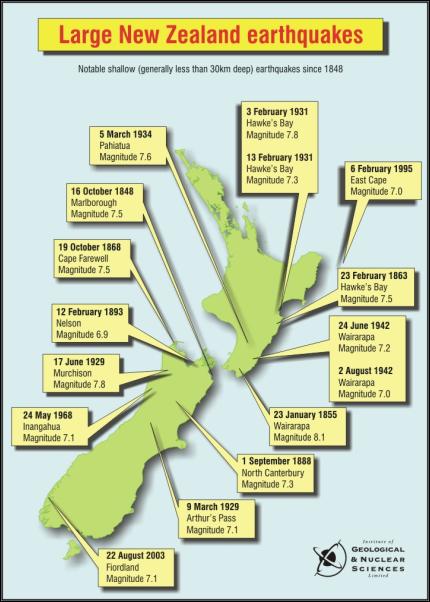Fiordland Quake Biggest For Many Years
Fiordland Quake Biggest For Many Years
Today's magnitude 7.1 earthquake in Fiordland ranks as one of the largest "on-land" earthquakes in New Zealand for many years, the Institute of Geological and Nuclear Sciences Ltd (GNS) said.
It occurred at 12.12am and has a provisional location of about 70km northwest of Te Anau and about 12km deep. This is close to Secretary Island, at the entrance to Doubtful Sound.

It was felt strongly in Te Anau, where there were reports of goods shaken off shelves. Many people in the southern half of the South Island were woken abruptly when the quake struck. Heavy damage is not expected outside the Fiordland region because the epicentre was a long way from populated areas.
" Coastal Fiordland is one of the most seismically active parts of New Zealand," said GNS seismologist Warwick Smith.
" The Australian and Pacific tectonic plates are being forced together in the Fiordland area resulting in stress and strain building up in the earth's crust. Earthquakes are a stress relief mechanism," Dr Smith said.
" A magnitude 6.2 aftershock was recorded at 2.12am at the same location. Aftershocks are likely to be frequent for several days, and smaller aftershocks will continue for months.
" Anyone in the vicinity of the epicentre would have felt dozens of aftershocks within a few hours of the main shock."
The Secretary Island area experienced an earthquake of magnitude 6.7 in 1993, and two others of magnitude 6.1 in 1988 and 1989.
The last on-land earthquake of comparable size to last night's main shock was at Inangahua on the West Coast on 24 May 1968. In February 1995 there was a magnitude 7.0 quake off East Cape, but little damage resulted because of its great distance offshore.
" On average, New Zealand can expect an earthquake of magnitude 7 or greater about once a decade and a magnitude 8 once every century."
GNS recorded the earthquake on the GeoNet national monitoring network. Its development has been funded by the Earthquake Commission and the Foundation for Research Science & Technology.
Duty seismologist Brian Ferris made the information available via the GeoNet website within 30 minutes of the earthquake.
A group of GNS seismologists will travel to Fiordland later today to deploy up to eight portable seismographs near the epicentre to record aftershocks.
Aftershocks are a rich source of information for seismologists. They provide information on the extent of the "fault break" in the crust and provide insights into what is likely to have caused the earthquake and its impact on any nearby faults.
Two years ago after a slightly smaller earthquake
near Jackson Bay on the West Coast, GNS seismologists
recorded 2000 aftershocks on their portable instruments over
a three week period. Most were small ? between magnitude 1
and 3. About 400 were useable for further analysis.


 NIWA: Students Representing New Zealand At The ‘Olympics Of Science Fairs’ Forging Pathway For International Recognition
NIWA: Students Representing New Zealand At The ‘Olympics Of Science Fairs’ Forging Pathway For International Recognition Coalition to End Big Dairy: Activists Protest NZ National Dairy Industry Awards Again
Coalition to End Big Dairy: Activists Protest NZ National Dairy Industry Awards Again Infoblox: Dancing With Scammers - The Telegram Tango Investigation
Infoblox: Dancing With Scammers - The Telegram Tango Investigation Consumer NZ: This Mother’s Day, Give The Gift Of Scam Protection And Digital Confidence
Consumer NZ: This Mother’s Day, Give The Gift Of Scam Protection And Digital Confidence NZ Airports Association: Airlines And Airports Back Visa Simplification
NZ Airports Association: Airlines And Airports Back Visa Simplification Netsafe: Statement From Netsafe About Proposed Social Media Ban
Netsafe: Statement From Netsafe About Proposed Social Media Ban